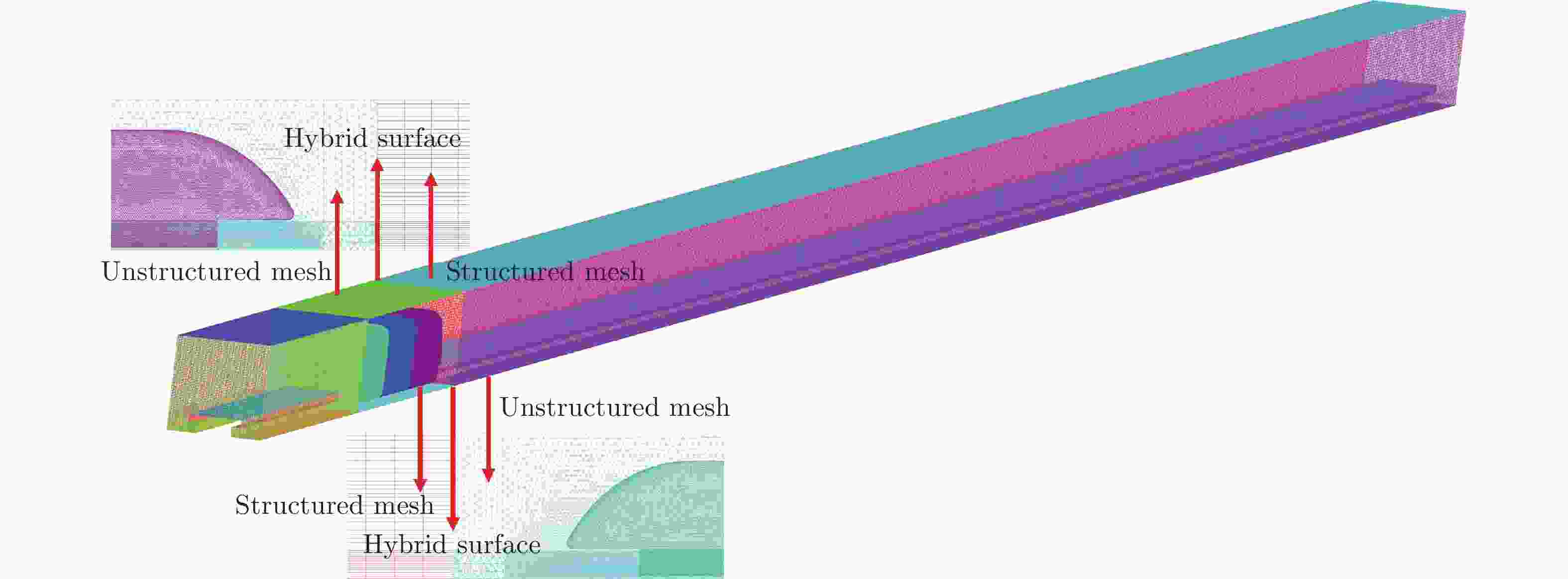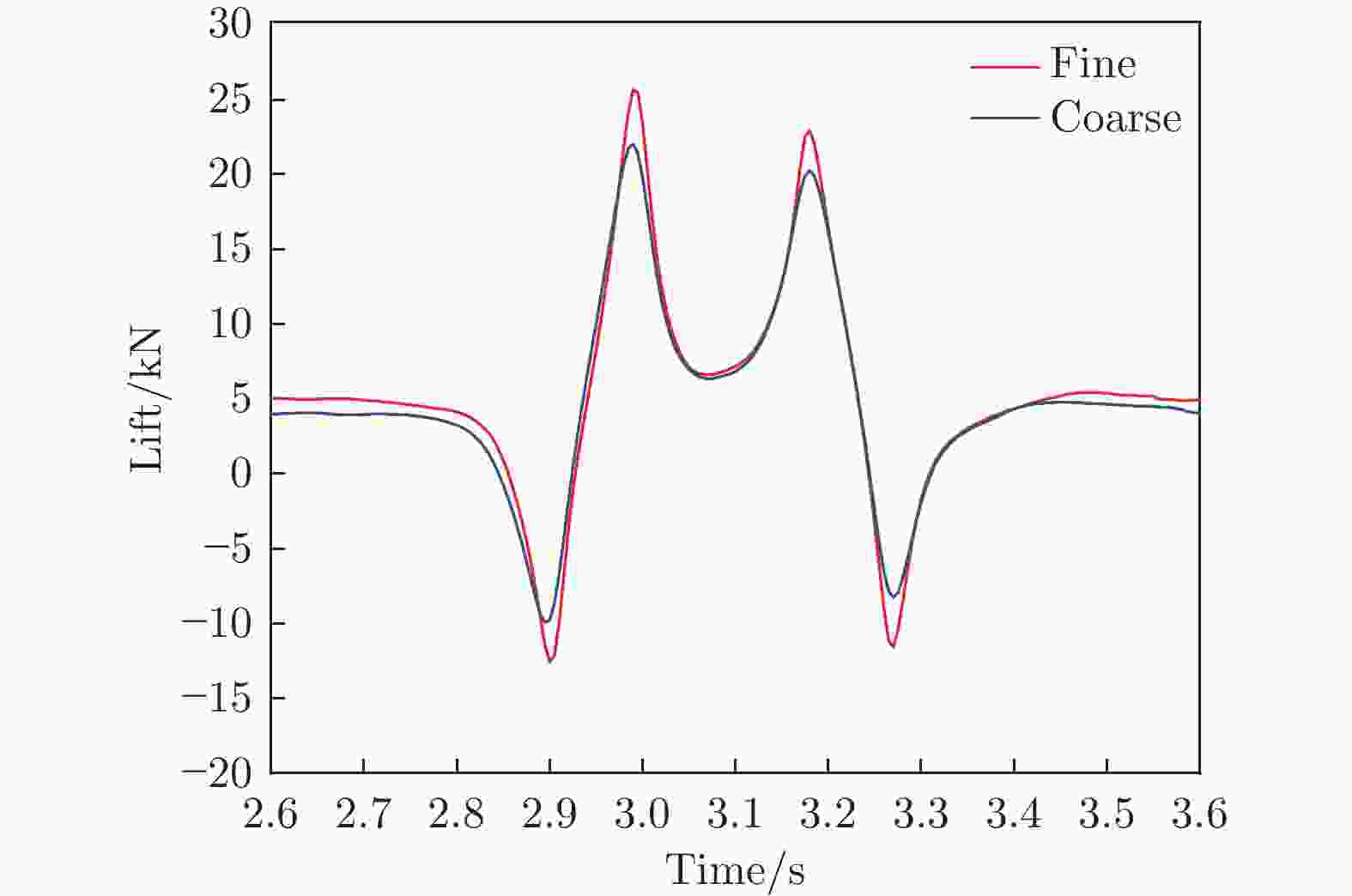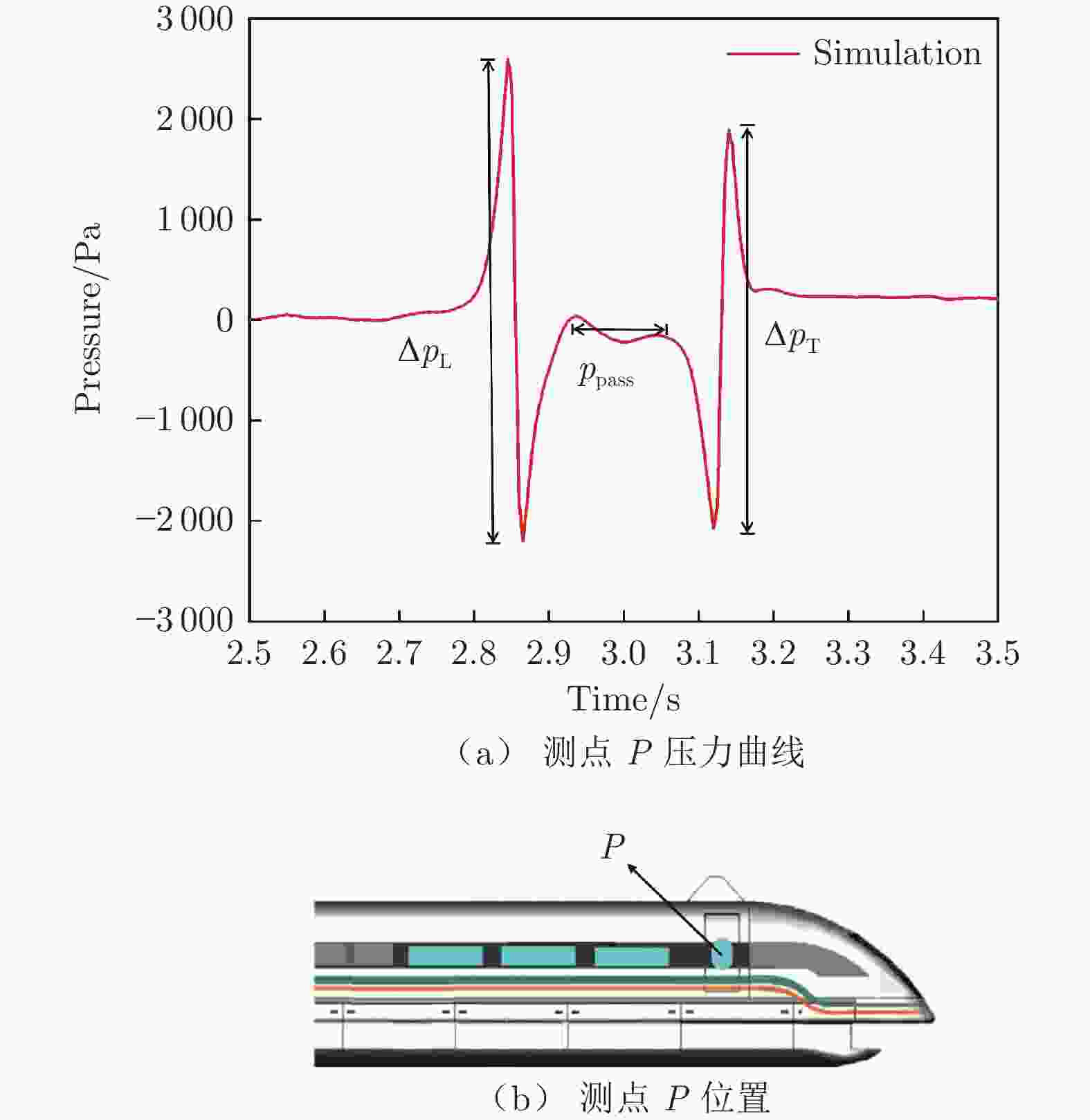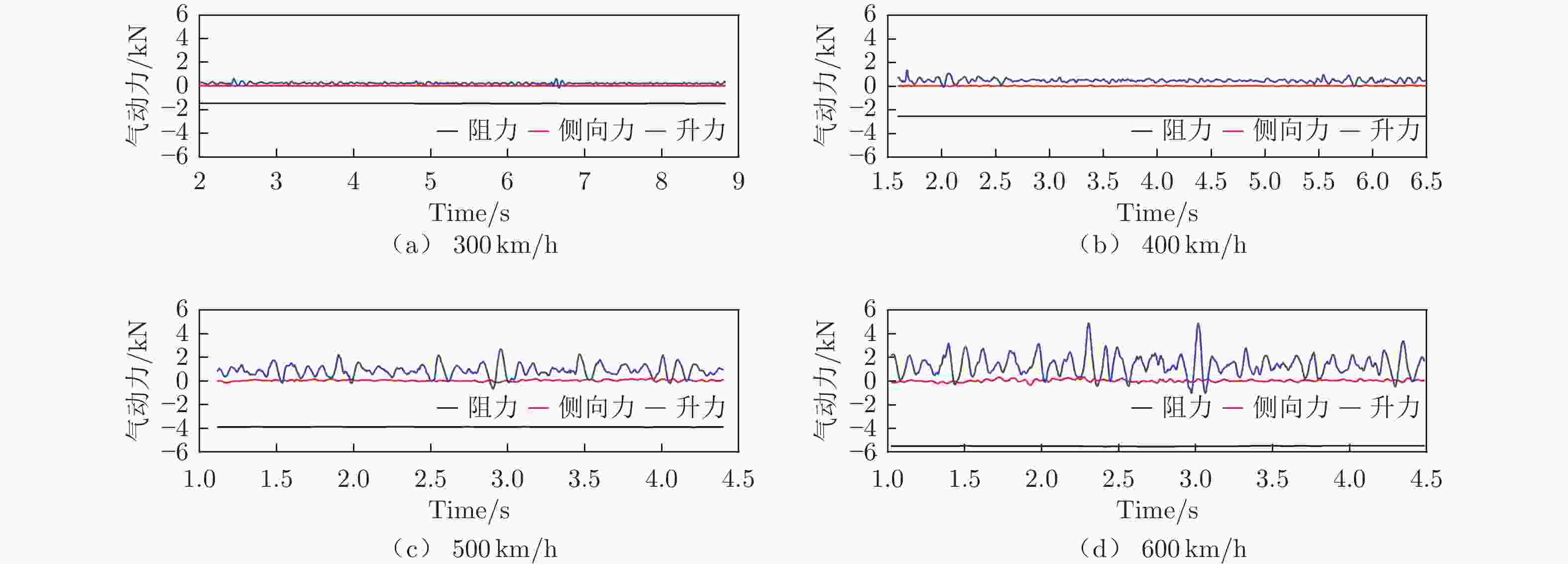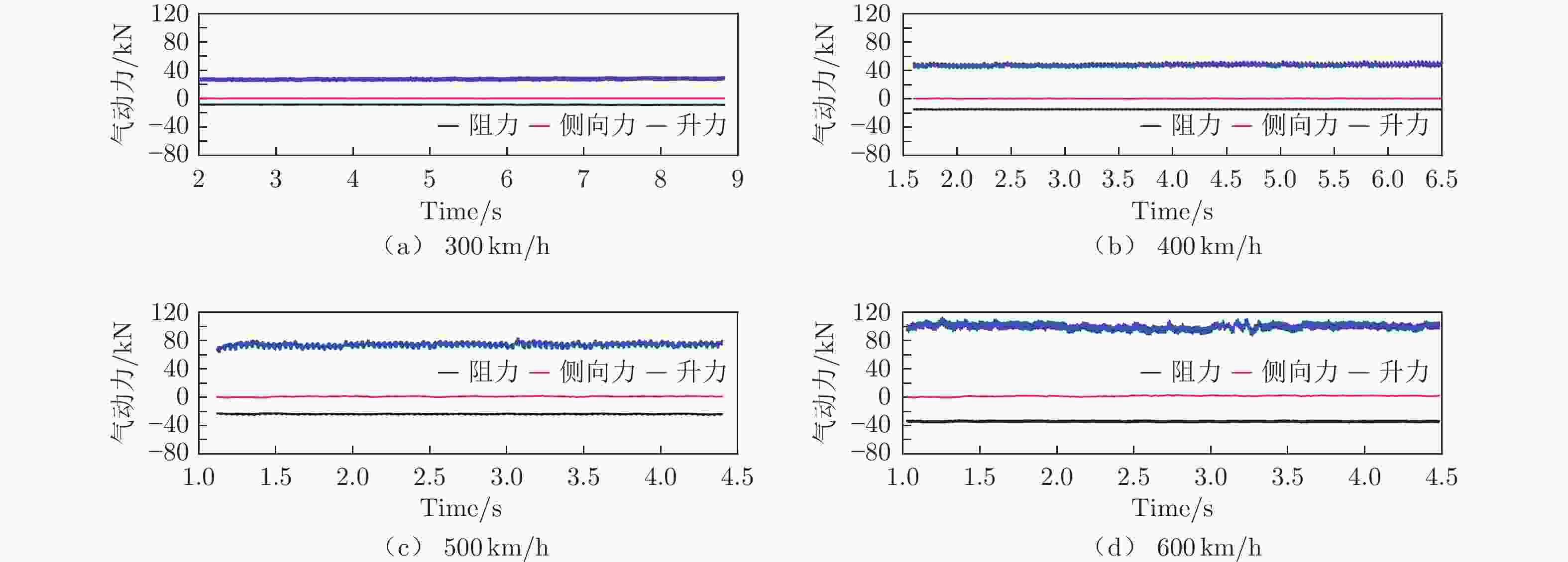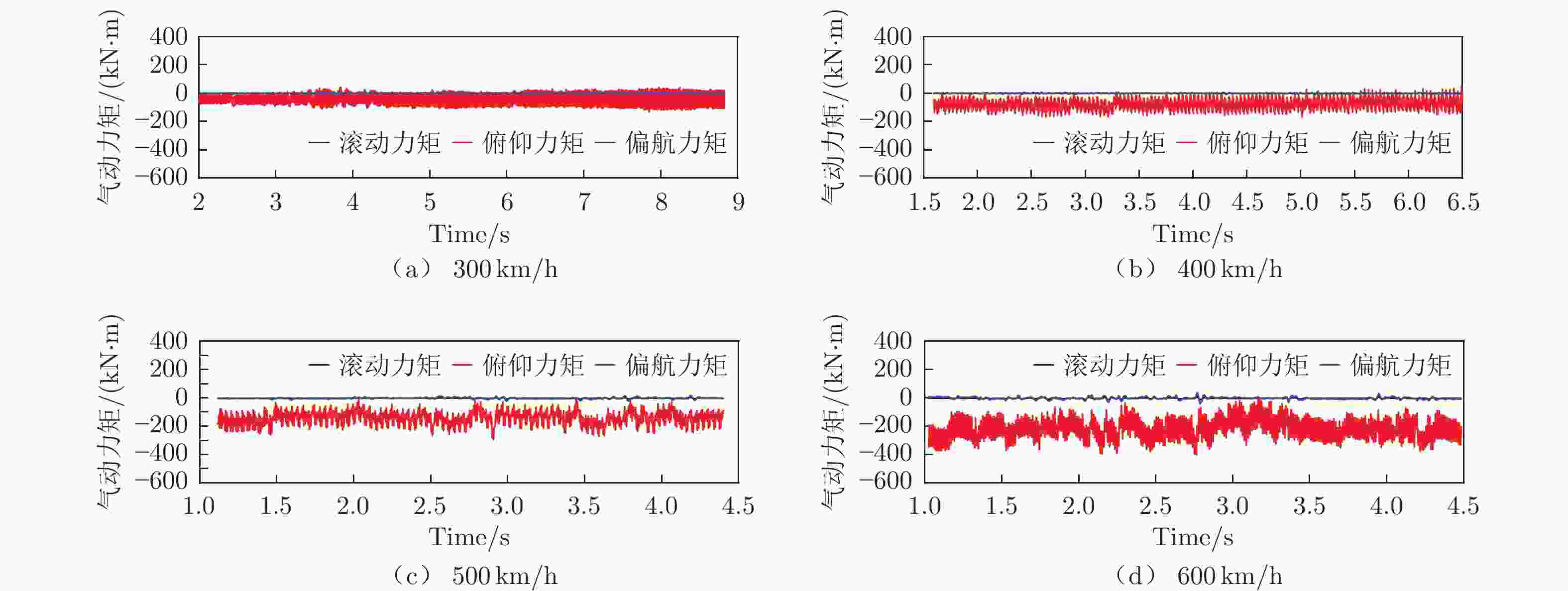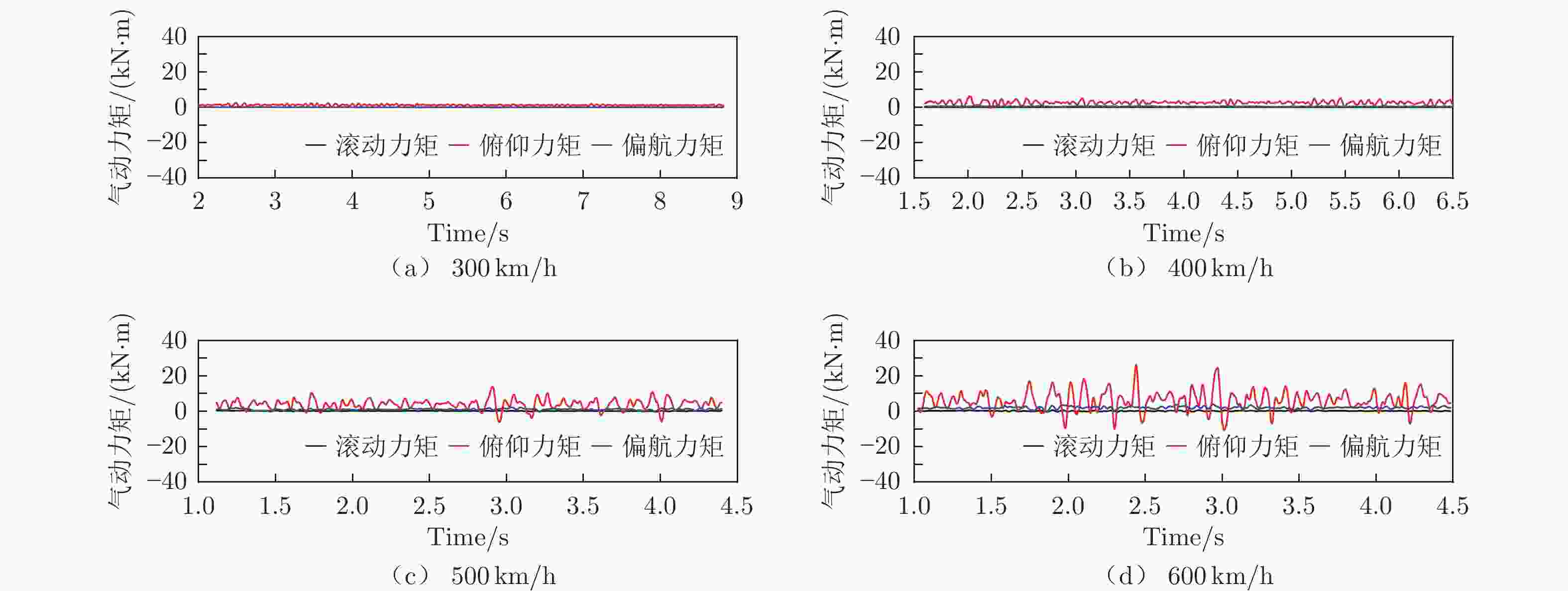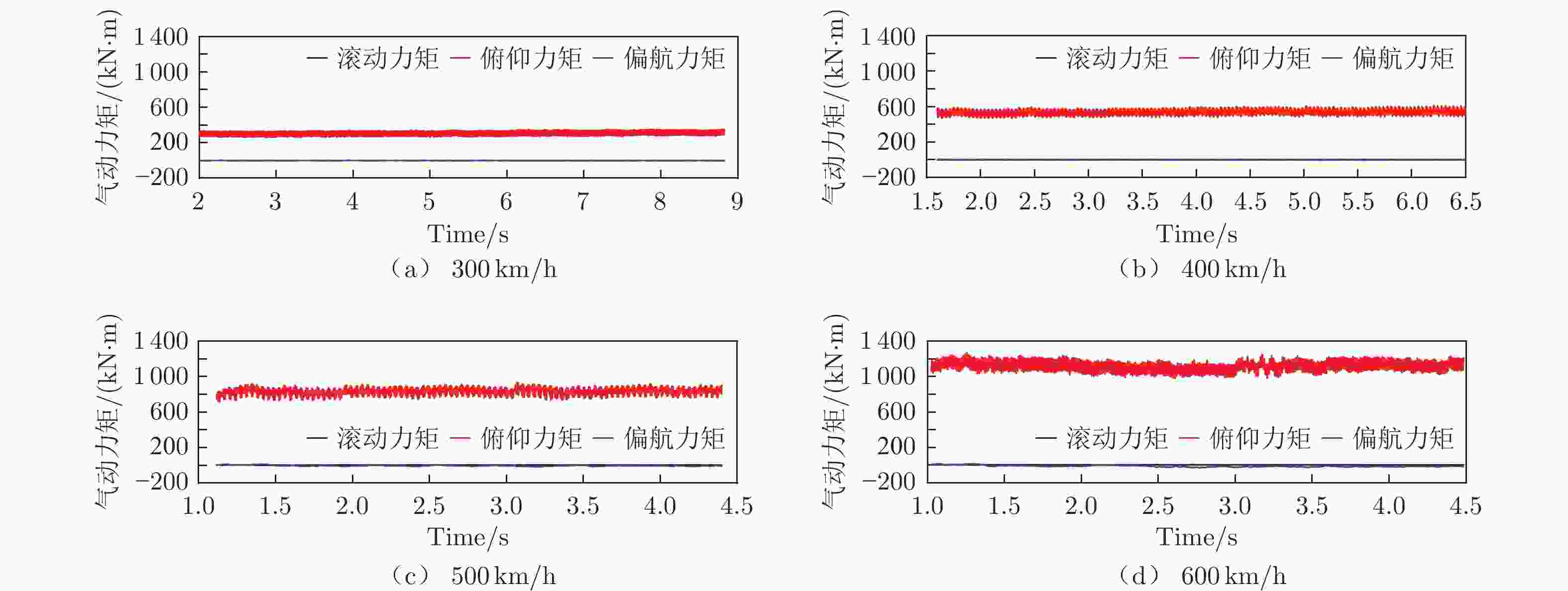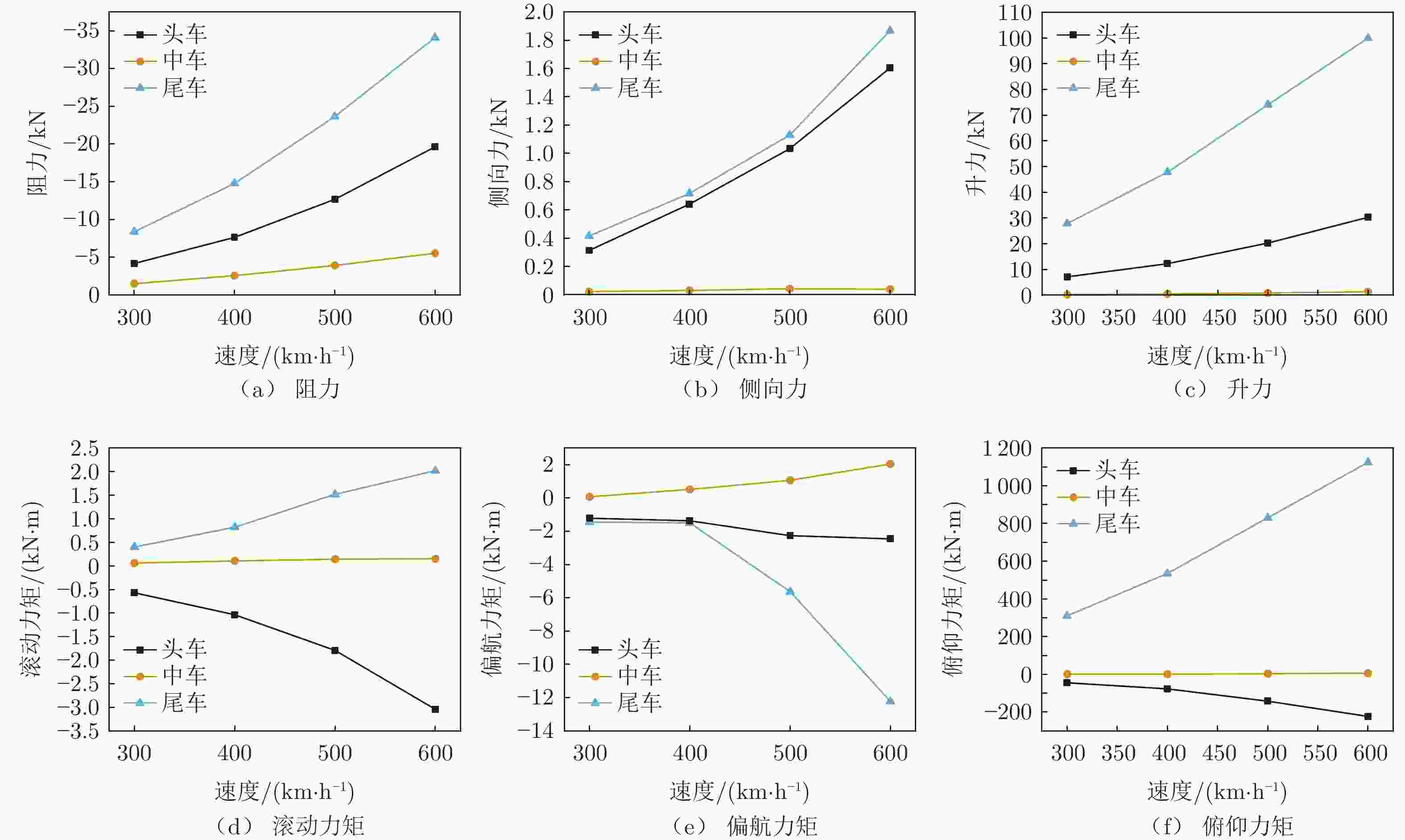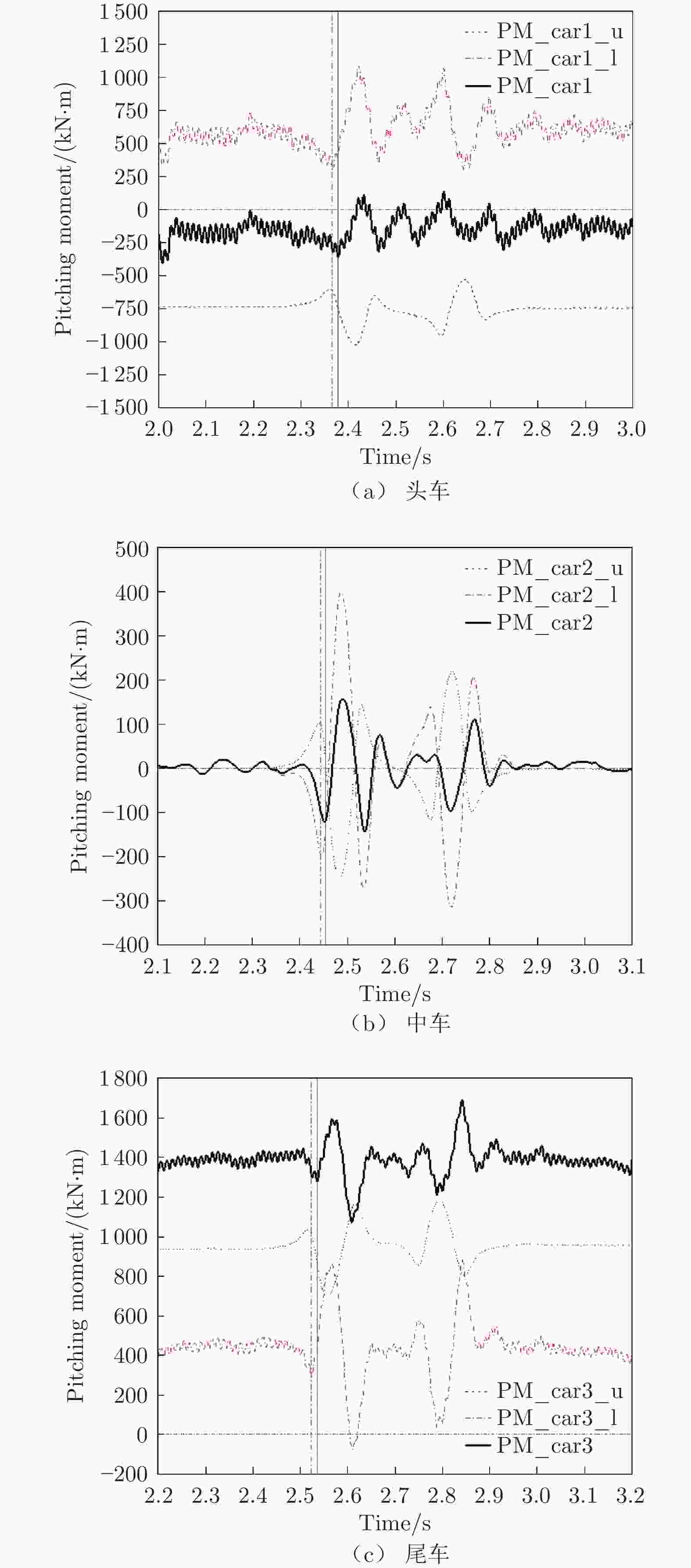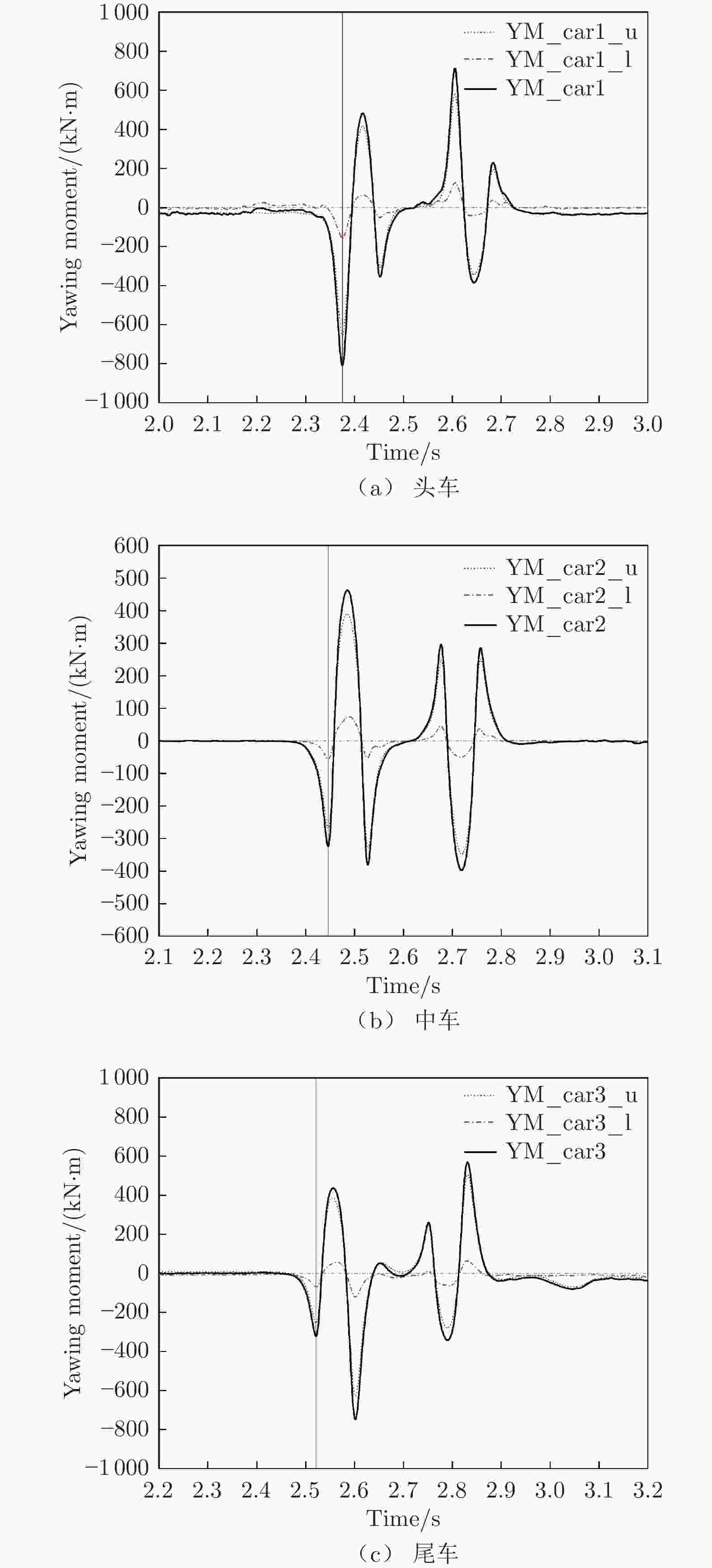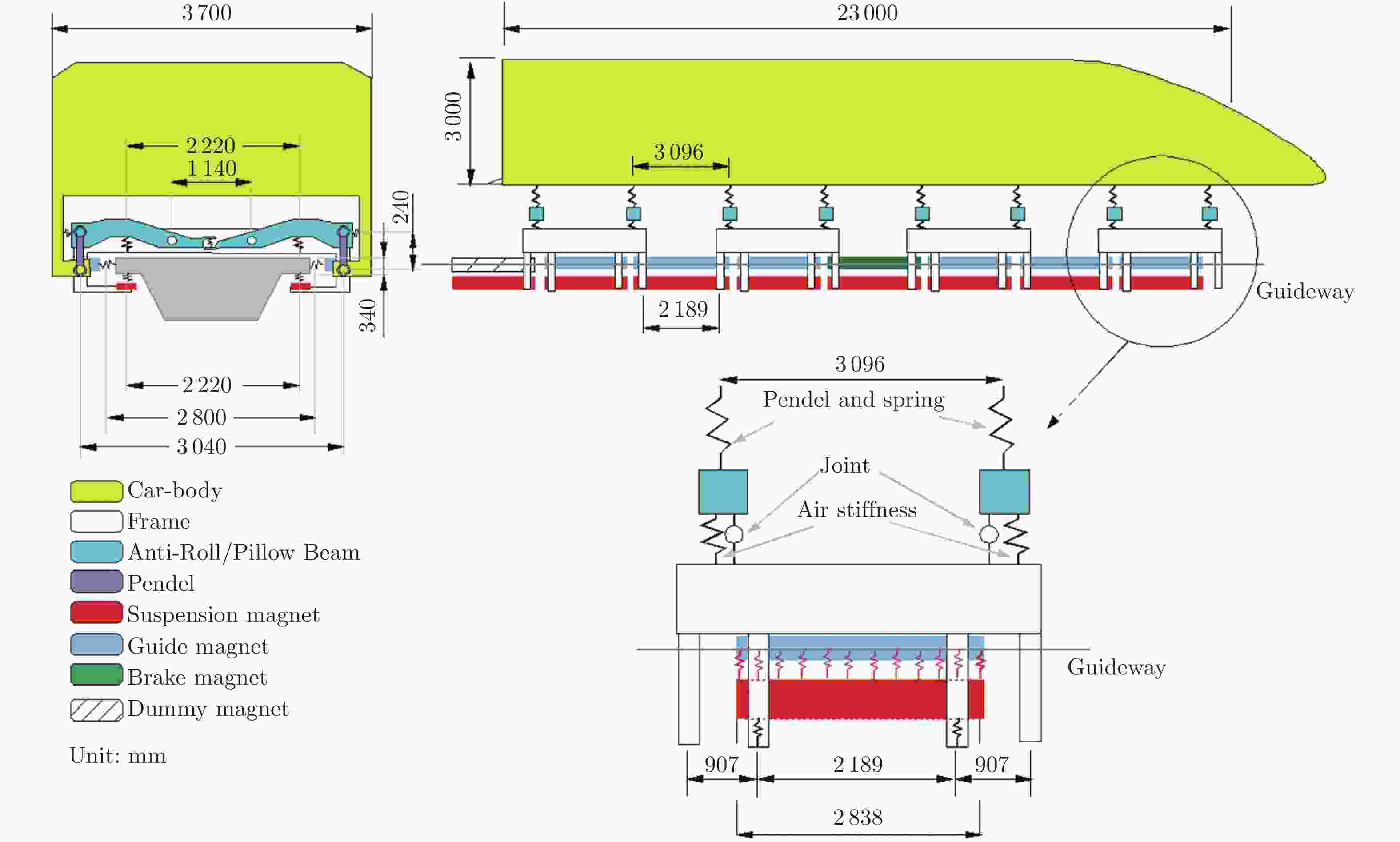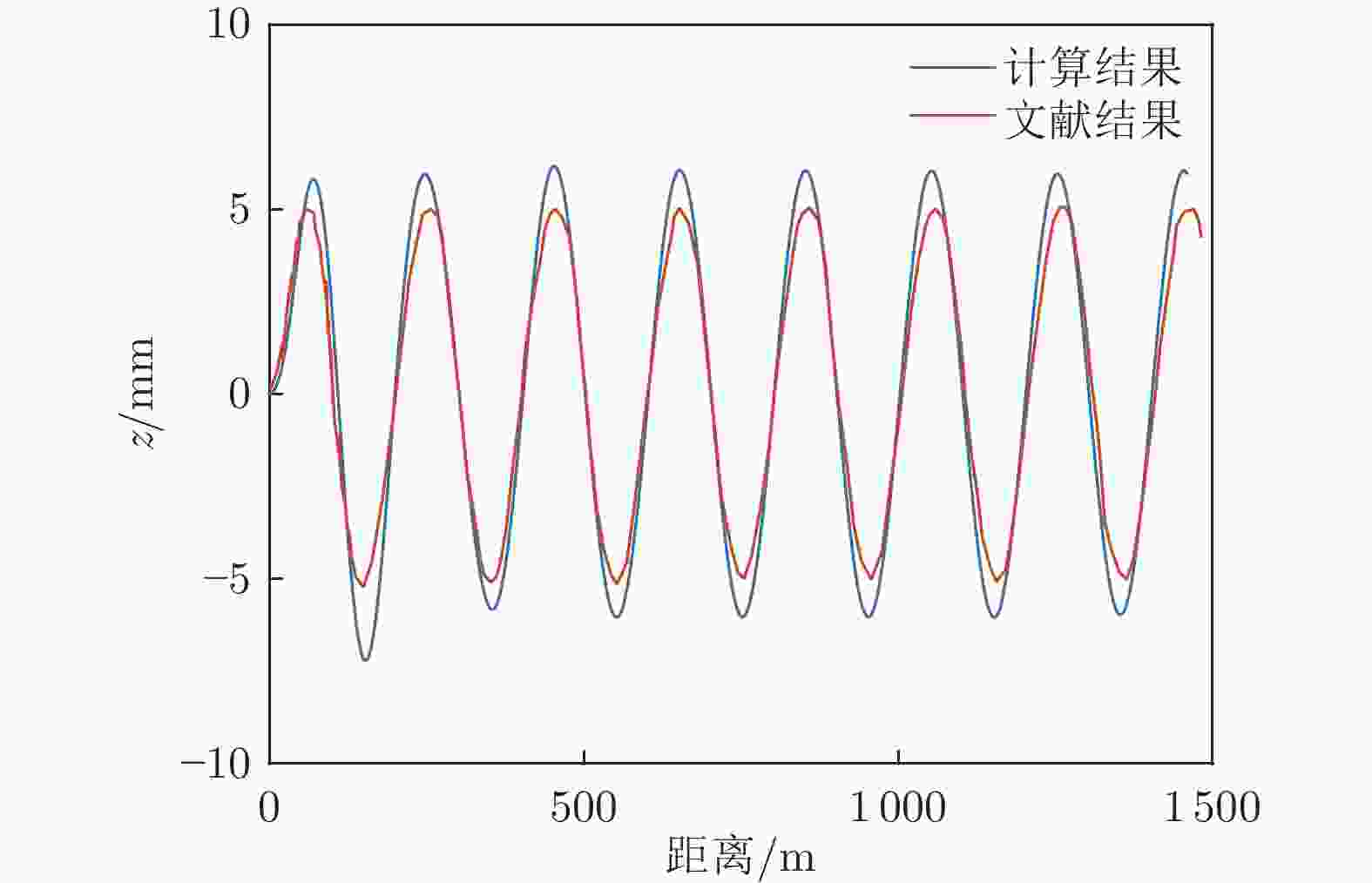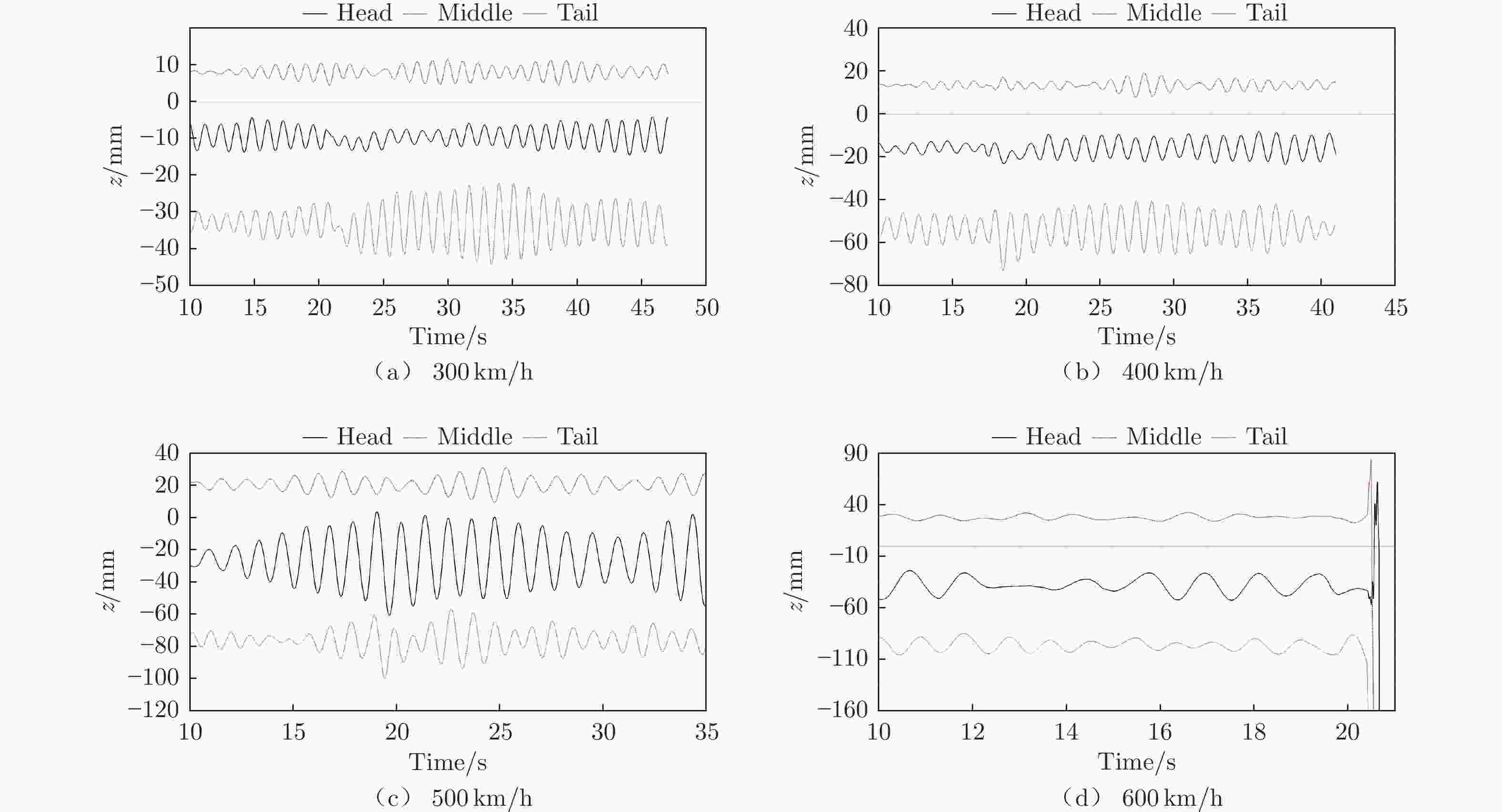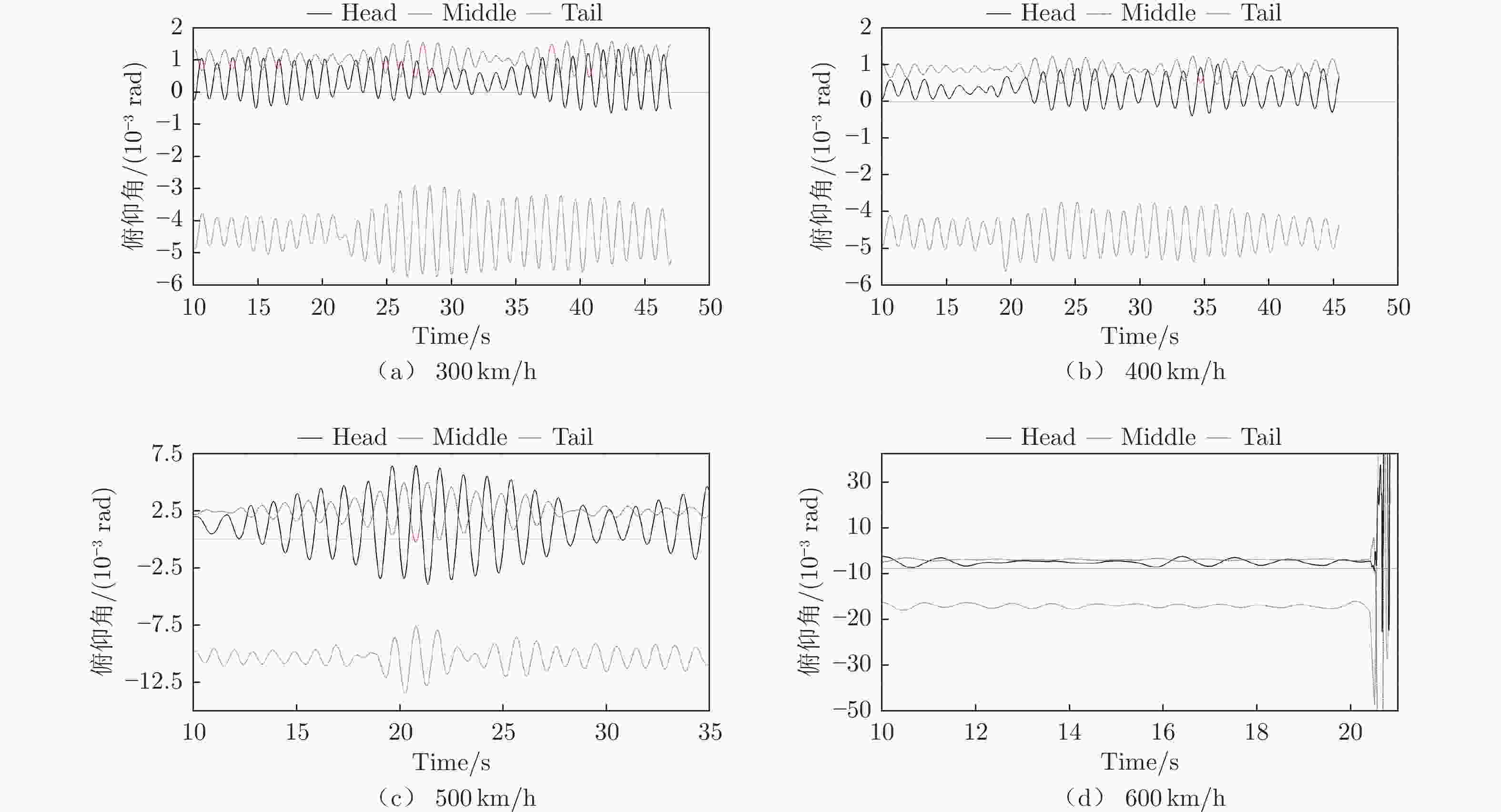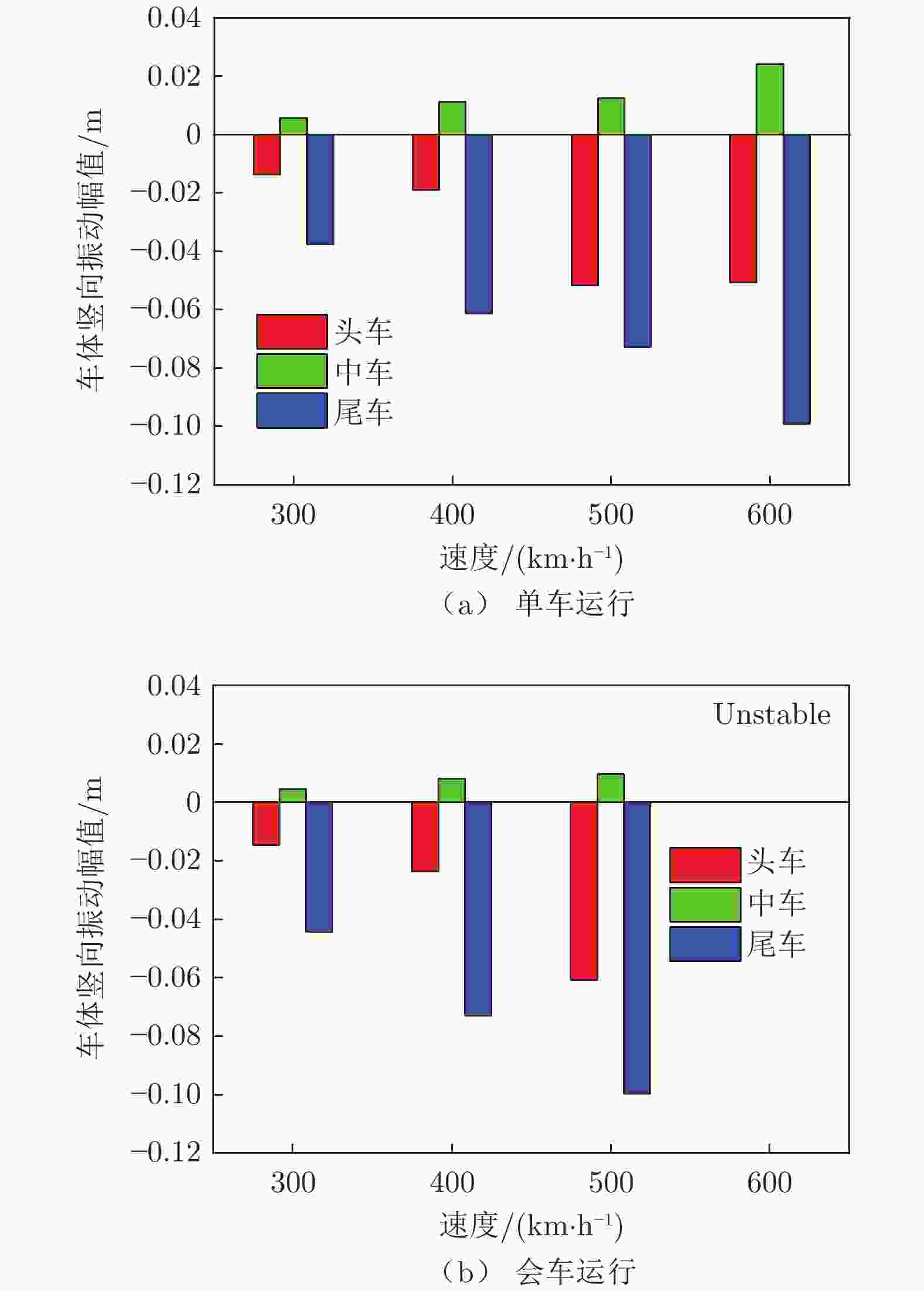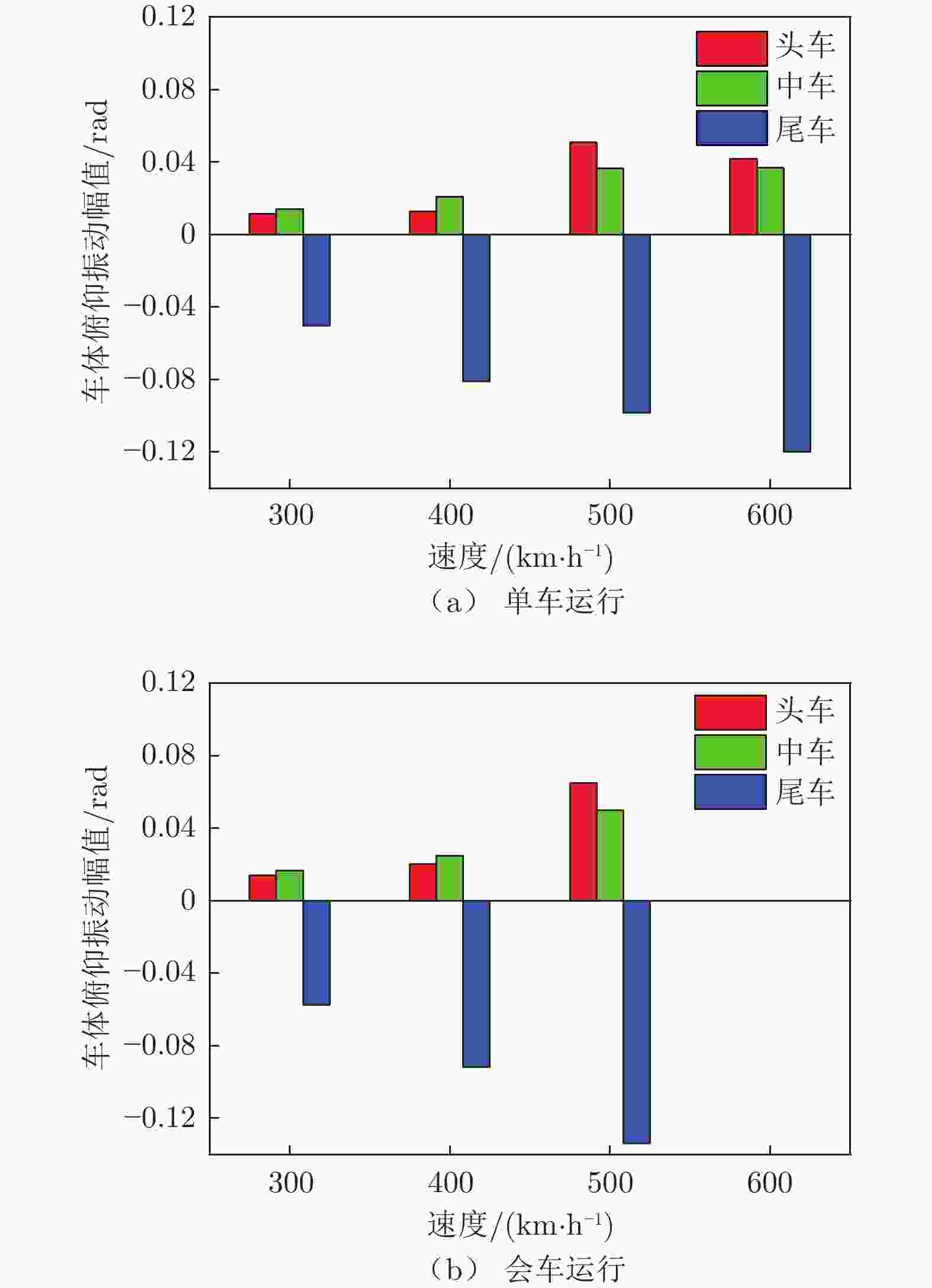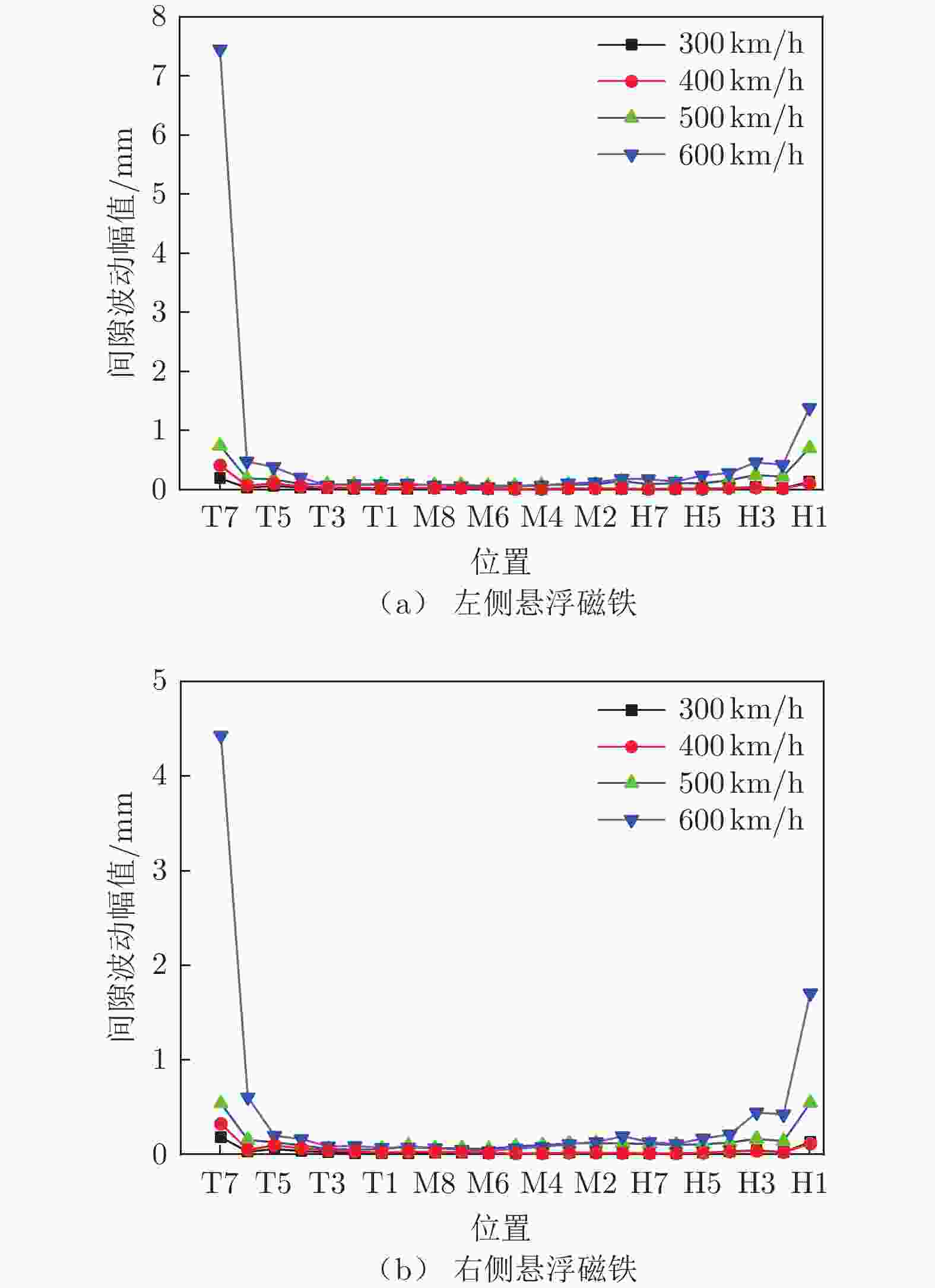Research of dynamic characteristics of maglev train under typical aerodynamic loads
-
摘要: 研究强气动荷载作用下磁浮列车的动力学特性对磁浮列车的悬浮稳定设计有重要意义。本文基于简化的TR08型磁浮列车,采用滑移网格方法,研究了明线单车运行和会车场景下作用在列车上的瞬态气动荷载特性、气动荷载振荡的来源及气动荷载作用下列车的动力学特性。结果表明:TR08型磁浮列车受到的气动荷载随速度的增大而增大,总体呈现尾车 > 头车 > 中车的规律。俯仰力矩在气动荷载中占主导地位,是影响列车安全运行最重要的因素。列车气动荷载振荡主要由下部结构引起,与上/下部结构相比,单节列车俯仰力矩的峰值出现了迟滞现象,偏航力矩则无此现象。单车以600 km/h的速度运行时,悬浮磁铁间隙波动的幅值将超过安全极限;以600 km/h的速度交会时,将发生失稳。本文的结论可为磁浮列车的稳定设计提供参考。Abstract: This study researched the dynamic characteristics of the TR08 maglev train under strong aerodynamic loads using the sliding grid method. The research investigated the transient aerodynamic load characteristics during open-track single-vehicle operation and meeting scenarios, identified the sources of aerodynamic load oscillation and the train's dynamic characteristics under these loads. Results show that the aerodynamic load of the TR08 maglev train increases with speed, and the pattern is tail train > head train > middle train. The lifting moment is critical for the safe operation of train, and substructure primarily causes load oscillation. The peak value of the pitching moment for a single-segment train shows a hysteresis phenomenon, which is absent in the yawing moment. When single train runs at 600 km/h suspension magnet gap fluctuation exceed safe limits, while when trains meet at 600 km/h instability occurs. This study provides insights into the sources of load oscillation and the train's dynamic characteristics.
-
Key words:
- high-speed maglev train /
- sliding mesh method /
- aerodynamic loading /
- dynamics characteristic /
- TR08 /
- vehicles meeting
-
表 1 数值模拟与实车实验压力对比
Table 1. Comparison of pressure
数值模拟结果/Pa 实车实验结果/Pa 相对误差 ΔpL 4834 4757 1.62% ppass 330 324 1.85% ΔpT 3804 3955 3.82% 表 2 单车运行气动力和气动力矩时均值
Table 2. Time-averaged values of single maglev train
速度/(km·h−1) 阻力/kN 侧向力/kN 升力/kN 滚动力矩/(kN·m) 俯仰力矩/(kN·m) 偏航力矩/(kN·m) 头车 300 −4.16 0.31 7.15 −0.57 −44.88 −1.22 400 −7.61 0.64 12.24 −1.04 −76.88 −1.36 500 −12.66 1.03 20.29 −1.79 −141.97 −2.26 600 −19.62 1.60 30.33 −3.04 −222.58 −2.45 中车 300 −1.48 0.02 0.23 0.06 1.30 0.08 400 −2.54 0.03 0.49 0.11 1.70 0.52 500 −3.90 0.04 0.88 0.14 3.92 1.07 600 −5.51 0.04 1.36 0.15 6.09 2.05 尾车 300 −8.36 0.42 27.89 0.40 310.44 −1.45 400 −14.78 0.55 47.86 0.82 535.17 −0.93 500 −23.63 1.13 74.08 1.52 830.92 −5.63 600 −34.13 1.87 100.04 2.02 1124.26 −12.23 表 3 磁浮架上部件的参数
Table 3. Parameters of components of the maglev frame
磁浮架上的部件 参数 A型空气弹簧 水平刚度:1.1 × 105 N/m
横向刚度:1.1 × 105 N/m
垂向刚度:1.9 × 105 N/mB型空气弹簧 水平刚度:1.2 × 105 N/m
横向刚度:1.2 × 105 N/m
垂向刚度:1.9 × 105 N/m摇臂间的扭转元件 横向刚度:1.0 × 106 N/m
垂向刚度:2.0 × 105 N/m
垂向阻尼:5.0 × 105 N·s/m横向止挡弹簧 横向刚度:2.2 × 104 N/m -
[1] 丁叁叁, 姚拴宝, 陈大伟. 高速磁浮列车气动升力特性[J]. 机械工程学报, 2020, 56(8): 228–234. doi: 10.3901/JME.2020.08.228DING S S, YAO S B, CHEN D W. Aerodynamic lift force of high-speed maglev train[J]. Journal of Mechanical Engi-neering, 2020, 56(8): 228–234. doi: 10.3901/JME.2020.08.228 [2] SICLARI M, ENDE R, CARPENTER G. The application of Navier-Stokes computations to the design of high-speed, low-drag magnetically levitated (Maglev) vehicle shapes[C]//Proc of the 13th Applied Aerodynamics Conference. 1995: 1908. doi: 10.2514/6.1995-1908 [3] TYLL J, LIU D, SCHETZ J, et al. Experimental studies of maglev aerodynamics[C]//Proc of the 13th Applied Aero-dynamics Conference. 1995: 1917. doi: 10.2514/6.1995-1917 [4] WELLS J, BRITCHER C. An aerodynamic study of an urban maglev vehicle[C]//Proc of the 48th AIAA Aerospace Sciences Meeting Including the New Horizons Forum and Aerospace Exposition. 2010: 1419. doi: 10.2514/6.2010-1419 [5] 李人宪, 刘应清, 翟婉明. 高速磁悬浮列车纵向及垂向气动力数值分析[J]. 中国铁道科学, 2004, 25(1): 8–12. doi: 10.3321/j.issn:1001-4632.2004.01.002LI R X, LIU Y Q, ZHAI W M. Numerical analysis of aerodynamic force in longitudinal and vertical direction for high-speed maglev train[J]. China Railway Science, 2004, 25(1): 8–12. doi: 10.3321/j.issn:1001-4632.2004.01.002 [6] 毕海权, 雷波, 张卫华. TR型磁浮列车气动力特性数值计算研究[J]. 铁道学报, 2004, 26(4): 51–54. doi: 10.3321/j.issn:1001-8360.2004.04.011BI H Q, LEI B, ZHANG W H. Research on numerical calculation for aerodynamic characteristics of the TR maglev train[J]. Journal of the China Railway Society, 2004, 26(4): 51–54. doi: 10.3321/j.issn:1001-8360.2004.04.011 [7] 刘堂红, 田红旗, 王承尧. 不同磁浮列车外形的气动性能比较[J]. 国防科技大学学报, 2006, 28(3): 94–98. doi: 10.3969/j.issn.1001-2486.2006.03.020LIU T H, TIAN H Q, WANG C Y. Aerodynamic performance comparison of several kind of nose shapes of maglev train[J]. Journal of National University of Defense Technology, 2006, 28(3): 94–98. doi: 10.3969/j.issn.1001-2486.2006.03.020 [8] HUANG S, LI Z W, YANG M Z. Aerodynamics of high-speed maglev trains passing each other in open air[J]. Journal of Wind Engineering and Industrial Aerodynamics, 2019, 188: 151–160. doi: 10.1016/j.jweia.2019.02.025 [9] YANG M Z, ZHONG S, ZHANG L, et al. 600 km/h moving model rig for high-speed train aerodynamics[J]. Journal of Wind Engineering and Industrial Aerodynamics, 2022, 227: 105063. doi: 10.1016/j.jweia.2022.105063 [10] 陈敬旭. 明线上高速磁浮列车交会时压力波与气动性能研究[D]. 兰州: 兰州交通大学, 2018.CHEN J X. Study on crossing air pressure pulse and aerodynamic performance of high-speed Maglev trains meeting in the open air[D]. Lanzhou: Lanzhou Jiaotong University, 2018. [11] GAO D G, NI F, LIN G B, et al. Aerodynamic analysis of pressure wave of high-speed maglev vehicle crossing: modeling and calculation[J]. Energies, 2019, 12(19): 3770. doi: 10.3390/en12193770 [12] 杨永刚, 杜云超, 梅元贵. 单列高速列车通过隧道空气阻力特性数值模拟研究[J]. 铁道科学与工程学报, 2018, 15(11): 2755–2763. doi: 10.19713/j.cnki.43-1423/u.2018.11.005YANG Y G, DU Y C, MEI Y G. Numerical simulation of aerodynamic drag of single high-speed train passing through a tunnel[J]. Journal of Railway Science and Engineering, 2018, 15(11): 2755–2763. doi: 10.19713/j.cnki.43-1423/u.2018.11.005 [13] ZHOU P, LI T, ZHAO C F, et al. Numerical study on the flow field characteristics of the new high-speed maglev train in open air[J]. Journal of Zhejiang University-SCIENCE A, 2020, 21(5): 366–381. doi: 10.1631/jzus.a1900412 [14] 罗宇豪, 池茂儒, 吴兴文, 等. 新型中低速磁浮车辆振动传递特性研究[J]. 科学技术与工程, 2022, 22(20): 8848–8855. doi: 10.3969/j.issn.1671-1815.2022.20.035LUO Y H, CHI M R, WU X W, et al. Vibration transmission characteristics of new medium-low speed magnetic levitation vehicle[J]. Science Technology and Engineering, 2022, 22(20): 8848–8855. doi: 10.3969/j.issn.1671-1815.2022.20.035 [15] 陆海英, 韩霄翰, 李忠继, 等. 中低速磁浮系统起浮阶段的振动特性分析[J]. 中国机械工程, 2019, 30(3): 318–324. doi: 10.3969/j.issn.1004-132X.2019.03.011LU H Y, HAN X H, LI Z J, et al. Analysis of vibration characteristics of low-medium speed maglev levitation systems in lifting stages[J]. China Mechanical Engineering, 2019, 30(3): 318–324. doi: 10.3969/j.issn.1004-132X.2019.03.011 [16] 刘耀宗, 邓文熙, 龚朴. 低速磁浮列车单悬浮架机电控制建模及动力学特性研究[J]. 铁道学报, 2014, 36(9): 39–43. doi: 10.3969/j.issn.1001-8360.2014.09.08LIU Y Z, DENG W X, GONG P. Dynamics-control modeling and analysis for bogie of low-speed maglev train[J]. Journal of the China Railway Society, 2014, 36(9): 39–43. doi: 10.3969/j.issn.1001-8360.2014.09.08 [17] 赵春霞. EMS型高速磁浮列车导向动力学研究[D]. 长沙: 国防科学技术大学, 2014.ZHAO C X. Research on guidance dynamics of EMS high-speed maglev train[D]. Changsha: National University of Defense Technology, 2014. [18] 舒瑶, 蒋忠城, 佟来生, 等. 横风荷载下电磁悬浮EMS型磁浮车辆动态响应特性分析[J]. 城市轨道交通研究, 2021, 24(12): 38–42. doi: 10.16037/j.1007-869x.2021.12.008SHU Y, JIANG Z C, TONG L S, et al. Dynamic response characteristics analysis of EMS maglev vehicle under cross wind loads[J]. Urban Mass Transit, 2021, 24(12): 38–42. doi: 10.16037/j.1007-869x.2021.12.008 [19] WU H, ZENG X H, GAO D G. Periodic response and stability of a maglev system with delayed feedback control under aerodynamic lift[J]. International Journal of Structural Stability and Dynamics, 2021, 21(03): 2150040. doi: 10.1142/S0219455421500401 [20] WU H, ZENG X H, YU Y. Motion stability of high-speed maglev systems in consideration of aerodynamic effects: a study of a single magnetic suspension system[J]. Acta Mechanica Sinica, 2017, 33(6): 1084–1094. doi: 10.1007/s10409-017-0698-z [21] LI M S, LEI B, LIN G B, et al. Field measurement of passing pressure and train induced airflow speed on high speed maglev vehicles[J]. Acta Aerodynamica Sinica, 2006, 24(2): 209–212. doi: 10.3969/j.issn.0258-1825.2006.02.013 [22] 李田, 张继业, 张卫华. 横风下车辆-轨道耦合动力学性能[J]. 交通运输工程学报, 2011, 11(5): 55–60. doi: 10.19818/j.cnki.1671-1637.2011.05.009LI T, ZHANG J Y, ZHANG W H. Coupling dynamics performance of vehicle-track under cross wind[J]. Journal of Traffic and Transportation Engineering, 2011, 11(5): 55–60. doi: 10.19818/j.cnki.1671-1637.2011.05.009 -








 下载:
下载:

